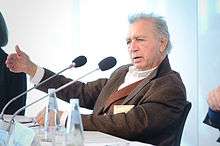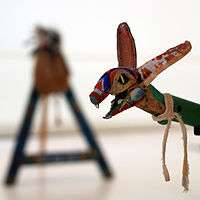Jimmie Durham
| Jimmie Durham | |
|---|---|
 Jimmie Durham in 2012 | |
| Born |
1940 (age 75–76) Washington, Arkansas |
| Nationality | American |
| Education | L'École des Beaux-Arts (Switzerland) |
| Known for | sculpture, poetry, installation art |
| Style | postmodern |
Jimmie Durham (born 1940) is an American-born sculptor, essayist and poet, living and working in Europe since 1994. He was active in the United States in the US civil rights movements of African Americans and Native Americans in the 1960s and 1970s, serving on the central council of the American Indian Movement (AIM). He returned to working at art while living in New York City. His work has been extensively exhibited.
He has long claimed to be Cherokee but that claim has been disputed by enrolled members of the Cherokee Nation. He has "no known ties to any Cherokee community."[1]
Background
Jimmie Durham was born in 1940 in Washington, Arkansas[2] and claimed to grow up in a Cherokee-speaking community. According to Cherokee lawyer, justice and law professor Steve Russell, Durham is among professional posers as Cherokee and Native American. He is described as having "made a career of being Cherokee with no known ties to any Cherokee community, although he has claimed to be Wolf Clan and to have been raised with Cherokee as a first language."[1]
In the 1960s Durham became active in theater, performance and literature related to the US civil rights movement in the 1960s.[3] His first solo exhibition as a visual artist was either in Austin, Texas in 1965[4] or 1968.[3] Durham moved to Geneva, Switzerland in 1969 where he studied at L'École des Beaux-Arts.[5][3]
Activism
In 1973, Durham returned to the United States and became involved with the American Indian Movement (AIM).[3] From 1973 until 1980 he worked as a political organizer with AIM, becoming a member of the movement’s Central Council and representing himself as Native American. Usually he claimed to be Cherokee[1] and wrote on behalf of the organization.[6]
In 1974, he attended International Indian Treaty Council (IITC) conference at the Standing Rock Indian Reservation.[7] He later became chief administrator of the IITC[8][7][9] and worked toward the United Nations granting the IITC status as a "Category II nongovernmental organization observer and consultant under the Economic and Social Council."[10] Durham befriended Winona LaDuke (White Earth Ojibwe) and encouraged her activism.[11] Paul Chaat Smith (Comanche) and Durham resigned from the IITC and AIM in 1979 over disagreements about AIM's support of Cuba and other Soviet allies.[12]
Art career

After moving to New York City, Durham, focused his attention to visual art. He created sculptures that challenged conventional representations of North American Indians. He exhibited and published essays frequently. From 1981 to 1983 he directed the Foundation for the Community of Artists in New York.[2] In 1983 West End Press published Columbus Day, a book of his poems. His poetry was included in Harper’s Anthology of 20th Century Native American Poetry (1988).
In 1987 Durham moved to Cuernavaca, Mexico.[3] During his time in Mexico, Durham exhibited widely, including at the Whitney Biennial, documenta IX, Institute of Contemporary Arts, London; Exit Art, the Museum of Modern Art, Antwerp; and the Palais des Beaux-Arts, Brussels. He also published a number of essays in periodicals, including Art Forum, Art Journal (CAA) and Third Text. In 1993 a collection of his essays, A Certain Lack of Coherence, was published by Kala Press.
After several years in Mexico, Durham moved to Europe in 1994, initially relocating to Berlin and then Naples. Since that time, he has focused primarily on the relationship between architecture, monumentality and national narratives. His anti-architectural sculptures, performances and videos seek to liberate architecture’s privileged material, stone, from its metaphorical associations with monumentality, stability and permanence. His exhibitions in Europe have included venues such as the Hamburg Kunstverein, FRAC in Reims, Haus Wittgenstein in Vienna, Kunstverein Munich, and the Venice Biennale, among many others. He participated in A Grain of Dust A Drop of Water: The 5th Gwangju Biennale in 2004. In 2005 Durham co-curated The American West, an attack on cowboy and Indian mythology, at Compton Verney, United Kingdom. In 2006 he also had various of his work displayed at the Serralves Foundation, in Porto, Portugal. In 2009, a permanent public art piece by Durham, Serpentine rouge, was installed in Indre, France, along the Loire River. In 2010 Durham presented his Rocks Encouraged in the Portikus exhibition hall in Frankfurt am Main, Germany.[13]
In 1995 Phaidon Press published Jimmie Durham, a comprehensive survey of his art, with contributions by Laura Mulvey, Dirk Snauwaert, and Mark Alice Durant. In 2009, a catalogue was published for a retrospective exhibition Pierre Rejetées... at Musée d'Art Moderne de la Ville de Paris.
Bibliography
- Durham, Jimmie. (1983) Columbus Day. Albuquerque, New Mexico: West End Press.
- Durham, Jimmie. (1992) 'Geronimo!', Partial Recall: Photos of Native North Americans. Lucy R. Lippard, ed. New York: The New Press. pp. 55–58.
- Durham, Jimmie. (1993) A Certain Lack of Coherence: Writings on Art and Cultural Politics. Jean Fisher, ed., London: Kala Press.
- Durham, Jimmie. (1993) Jimmie Durham: My Book, The East London Coelacanth. London: ICA Book Works.
- Durham Jimmie. (1994) "A friend of mine said that Art is an European Invention", "Global Visions, Toward a New Internationalis in the Visual Arts"London, Kala Press.
- Durham, Jimmie. (1994) 'Jimmie Durham: Interviewed by Mark Gisbourne', Art Monthly February. 173. pp. 7–11.
- Durham, Jimmie. (1995) 'Attending to Words and Bones: An Interview with Jean Fisher', Art and Design. vol. 10, nos. pp. 7–8. 47-55.
- Durham, Jimmie. (1996) Eurasian Project, Stage One: La porte de l’Europe (Les Bourgeois de Calais, La Leon d’Anatomie. A Progress Report). Champagne-Ardenne, Calais, Anvers: Le College Editions, Galerie de l’ Ancienne Poste, Galerie Micheline Szwajcer.
- Durham, Jimmie. (1996) Der Verführer und der Steinerne Gast. Vienna: Springer Verlag
- Durham, Jimmie. (1998) Jimmie Durham: Between the Furniture and the Building (Between a Rock and a Hard Place). Munich: Kunstverein München.
- Durham, Jimmie. (1998) "The Centre of the World is Several Places (Parts I & II)." Interview by Beverly Koski and Richard William Hill (Berlin, February 1998). FUSE Magazine vol. 21, nos. 3 & 4, 1998. pp. 24–33 & 46-53, respectively.
- Durham, Jimmie. (2001) Stone Heart. Kitakyushu, Japan: Centre for Contemporary Art, Kitakyushu.
- Durham, Jimmie. (2001). 'Belief in Europe', in S. Hassan & I. Dadi (eds.). Unpacking Europe. Rotterdam: Museum Boijmans Van Beuningen/Nai Publishers, pp. 290–293.
- Durham, Jimmie. (2004). 'Situations', in C. Doherty (ed.). Contemporary Art: from Studio to Situation. London: Black Dog Publishing, pp. 177–183
- Durham, Jimmie. (2004). 'Stones Rejected by the Builder', in G. Di Pietrantonio, et al.. Jimmie Durham. Milan: Charta, Fondazione Antonio Ratti, pp. 117–130.
- Durham, Jimmie. (2005) The Second Particle Wave Theory. As Performed on the Banks of the River Wear, a Stone’s Throw from S’Underland and the Durham Cathedral. Sunderland, UK/ Banff: University of Sunderland/Walter Phillips Gallery.
- Durham, Jimmie. (2005) 'Various Element of Cowboy Life' & 'Cherokee-US Relations' The American West. Compton Verney, Warwickshire: Compton Verney House Trust. pp. 9–22 & 51-59 respectively.
- Durham, Jimmie. (2011). Amoxohtli/Libro de Carretera/A Road Book. Köln: Walther König.
See also
Notes
- 1 2 3 Steve Russell, Editorial: " Rachel Dolezal Outs Andrea Smith Again; Will Anybody Listen This Time?", Indian Country Today Media Network, 1 July 2015, accessed 10 January 2016
- 1 2 Johansen 110
- 1 2 3 4 5 Schulman, Schulman (3 January 2016). "Artist Jimmie Durham drops boulders to stop time". News from Indian Country. Retrieved 11 September 2016.
- ↑ Johansen 110
- ↑ Johansen 110
- ↑ ""The Process of Coming Back into the World": An American Indian Movement (A.I.M.) Activist Advocates Cultural and Political Unification". History Matters. American Social History Project / Center for Media and Learning (Graduate Center, CUNY). Retrieved 11 September 2016.
- 1 2 Tóth 72
- ↑ Tóth 152
- ↑ Johansen 29–30, 155
- ↑ Tóth 152
- ↑ Johansen 165–169
- ↑ Johansen 155
- ↑ "Jimmie Durham: Rocks Encouraged". e-flux. 2 June 2010. Retrieved 9 September 2016.
References
- Johansen, Bruce Elliott (2013). Encyclopedia of the American Indian Movement. Santa Barbara, CA: ABC-CLIO. ISBN 978-1-4408-0317-8.
- Tóth, György Ferenc (2016). From Wounded Knee to Checkpoint Charlie: The Alliance for Sovereignty. Albany, NY: SUNY Press. ISBN 978-1-4384-6121-2.
Further reading
- Laura Mulvey, Jimmie Durham, Dirk Snauwaert, and Mark Alice Durant. Jimmie Durham. London: Phaidon, 1995. ISBN 978-0-7148-3348-4.
External links
| Wikimedia Commons has media related to Jimmie Durham. |
- Lucy Lippard, "Jimmie Durham: Postmodernist Savage", Art In America from FindArticles.com
- Steve Russell, Editorial: " Rachel Dolezal Outs Andrea Smith Again; Will Anybody Listen This Time?", Indian Country Today Media Network, 1 July 2015; includes comment that Durham has posed as Cherokee and Native American
- Critique de l'exposition Pierres rejetées, au Musée d'art moderne de la ville de Paris, sur paris-art.com, in French
- Jimmie Durham on culturbase.net
- Artist’s Portrait: Jimmie Durham, by Johannes Schlebrügge (Museum in Progress, 2000)
- Serpentine rouge, public art piece by Jimmie Durham, 2009, France
- Video portrait of Jimmie Durham, solo exhibition at M HKA (Antwerp) in 2012.